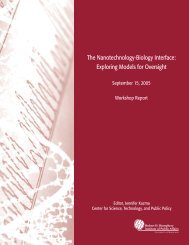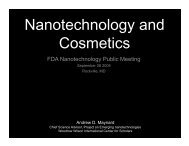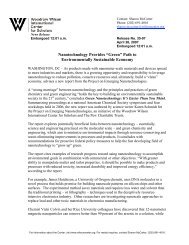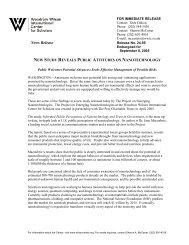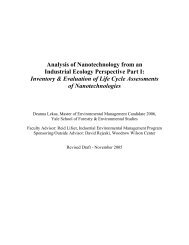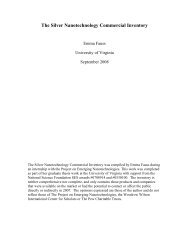nanotechnology oversight - Project on Emerging Nanotechnologies
nanotechnology oversight - Project on Emerging Nanotechnologies
nanotechnology oversight - Project on Emerging Nanotechnologies
You also want an ePaper? Increase the reach of your titles
YUMPU automatically turns print PDFs into web optimized ePapers that Google loves.
4<br />
vivid examples of how adverse public opini<strong>on</strong><br />
can block or slow the development and applicati<strong>on</strong><br />
of new technologies; examples include<br />
nuclear power, genetically modified crops and<br />
stem cell research. Nanotechnology could meet<br />
the same fate (Mandel 2005). The public’s reacti<strong>on</strong>s<br />
to new technologies are determined by a<br />
variety of factors, many of them not in the<br />
realms of science or rati<strong>on</strong>ality; however, there<br />
is evidence that the perceived adequacy of <str<strong>on</strong>g>oversight</str<strong>on</strong>g><br />
of the technology is an important c<strong>on</strong>siderati<strong>on</strong><br />
in shaping people’s views (Macoubrie<br />
2005). Recent surveys have indicated declining<br />
trust in both government and industry to manage<br />
the risks of emerging technologies (Hart<br />
2007). Although there is little public support<br />
for a moratorium <strong>on</strong> <str<strong>on</strong>g>nanotechnology</str<strong>on</strong>g> research<br />
and development (which some n<strong>on</strong>-government<br />
organizati<strong>on</strong>s have called for), there is<br />
likewise little support for industry self-regulati<strong>on</strong>.<br />
One highly publicized adverse effect could<br />
threaten all the applicati<strong>on</strong>s and social benefits<br />
of <str<strong>on</strong>g>nanotechnology</str<strong>on</strong>g>.<br />
Many knowledgeable people think that it is<br />
premature to establish str<strong>on</strong>g <str<strong>on</strong>g>oversight</str<strong>on</strong>g> of <str<strong>on</strong>g>nanotechnology</str<strong>on</strong>g><br />
because we do not yet know<br />
enough about its possible adverse effects.<br />
Certainly we have much to learn. We do not<br />
know enough about what effects may occur<br />
outside the laboratory, we do not understand<br />
which characteristics of nanomaterials determine<br />
the toxicity of the material and we do<br />
not understand how most nanomaterials travel<br />
in the envir<strong>on</strong>ment. Many companies<br />
involved with <str<strong>on</strong>g>nanotechnology</str<strong>on</strong>g> are aware of<br />
the potential risks but lack both the guidance<br />
and scientific know-how to address them. The<br />
lack of a clear road map is especially problematic<br />
for the small, innovative firms that make<br />
up much of the <str<strong>on</strong>g>nanotechnology</str<strong>on</strong>g> landscape<br />
(Lindberg and Quinn 2007).<br />
Despite the large gaps in knowledge,<br />
enough is known to begin testing nanomaterials<br />
for safety. The Internati<strong>on</strong>al Life<br />
Sciences Institute has suggested a testing<br />
regime for nanomaterials, DuP<strong>on</strong>t and<br />
Envir<strong>on</strong>mental Defense have produced a<br />
detailed framework for analyzing the possible<br />
effects of <str<strong>on</strong>g>nanotechnology</str<strong>on</strong>g> products and the<br />
Organizati<strong>on</strong> for Ec<strong>on</strong>omic Cooperati<strong>on</strong> and<br />
Development (OECD) is committed to testing<br />
several generic types of nanomaterials.<br />
Regulatory requirements are needed to amass<br />
enough test data to determine the technology’s<br />
effects. To move the science of nanotoxicology<br />
forward, it is necessary to have toxicity<br />
data <strong>on</strong> a large number of nanomaterials<br />
and products. These data will not be generated<br />
or made known if companies are not<br />
required to do so.<br />
Without an adequate <str<strong>on</strong>g>oversight</str<strong>on</strong>g> system we<br />
cannot protect the public when adverse effects<br />
are identified. A lack of acti<strong>on</strong> invites significant<br />
damage to people or the envir<strong>on</strong>ment,<br />
and/or a public reacti<strong>on</strong> that impedes development<br />
of the technology. The new administrati<strong>on</strong><br />
needs to ensure that neither of these<br />
outcomes occurs.<br />
THE CURRENT SITUATION<br />
Both the states and the federal government<br />
have c<strong>on</strong>centrated <strong>on</strong> <str<strong>on</strong>g>nanotechnology</str<strong>on</strong>g> primarily<br />
as an instrument of ec<strong>on</strong>omic development.<br />
The Nati<strong>on</strong>al Nanotechnology<br />
Initiative (NNI) is the federal structure for<br />
promoting the development and use of <str<strong>on</strong>g>nanotechnology</str<strong>on</strong>g>.<br />
Military applicati<strong>on</strong>s of <str<strong>on</strong>g>nanotechnology</str<strong>on</strong>g><br />
come under the NNI umbrella.<br />
Four federal regulatory bodies—the FDA,<br />
the Envir<strong>on</strong>mental Protecti<strong>on</strong> Agency (EPA),<br />
the C<strong>on</strong>sumer Product Safety Commissi<strong>on</strong><br />
(CPSC) and the Occupati<strong>on</strong>al Safety and



